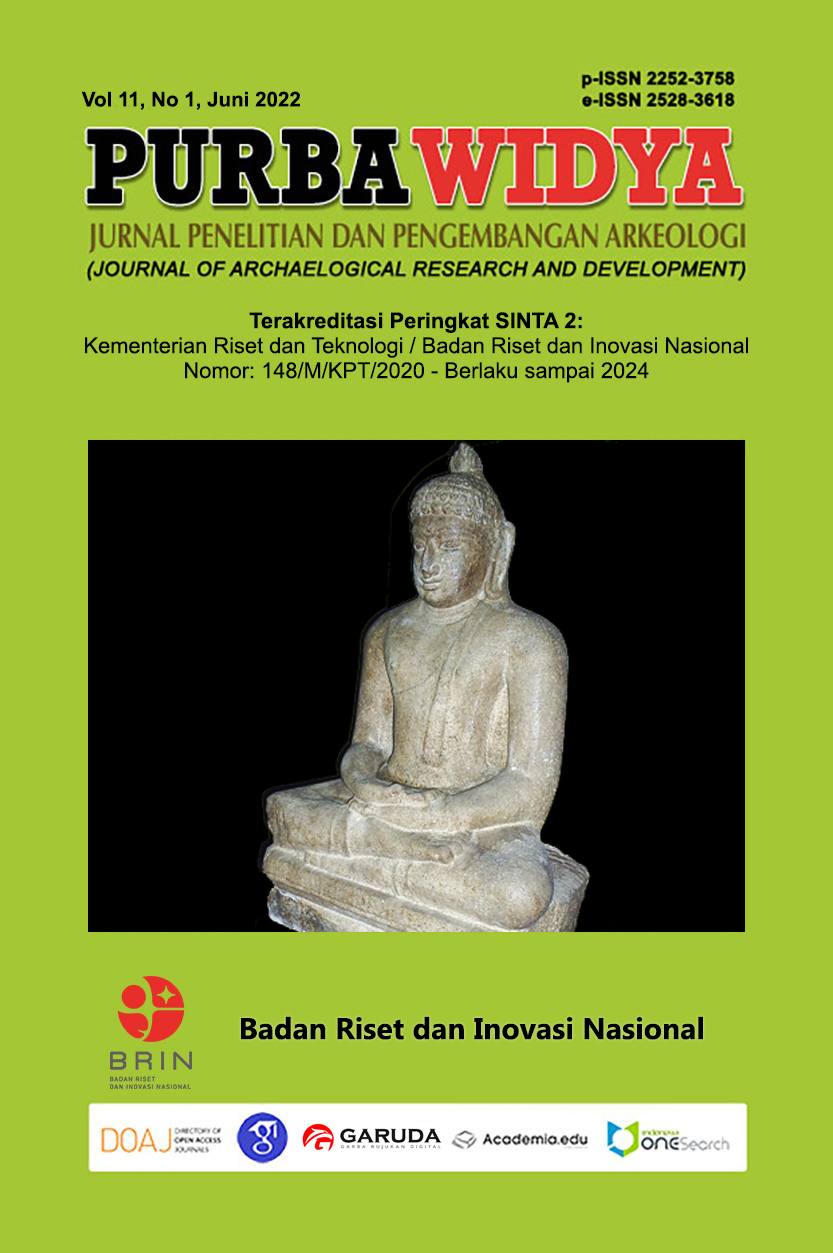Kerusakan Lingkungan Akibat Sampah Kulit Kerang di Situs Kota Cina Medan
Main Article Content
Abstract
The China Town in the past was one of the important trading ports in the archipelago, this is proven by the abundance of findings from archaeological excavations at the site. The decline of China Town as a trading city is recorded in people's memories in the form of speech stories. The story that is quite well known and developed in the community that makes China Town abandoned by its inhabitants is due to the attack of kepah (a type of sea shell) that comes from the sea. As a result, people flocked to leave the city. This story continues to this day. This paper aims to explain scientifically the speech stories that developed in the community associated with data from archaeological research that has been carried out at the site. From the results of excavations carried out, it is found that in various locations, kitchen waste is almost always found in the form of concentrations of shells. This results in environmental damage in the form of river silting, and the closure of the soil surface due to shell waste. These two things make China Town uncomfortable to live in and then abandoned.
Article Details

This work is licensed under a Creative Commons Attribution-NonCommercial-ShareAlike 4.0 International License.
Authors who publish with this journal agree to the following terms:
- Authors retain copyright and grant the journal right of first publication with the work simultaneously licensed under Creative Commons Attribution-NonCommercial-ShareAlike 4.0 International License that allows others to share the work with an acknowledgement of the work's authorship and initial publication in this journal.
- Authors are able to enter into separate, additional contractual arrangements for the non-exclusive distribution of the journal's published version of the work (e.g., post it to an institutional repository or publish it in a book), with an acknowledgment of its initial publication in this journal.
- Authors are permitted and encouraged to post their work online (e.g., in institutional repositories or on their website) prior to and during the submission process, as it can lead to productive exchanges, as well as earlier and greater citation of published work (See The Effect of Open Access).
References
Chabot, Y., Yann Le Drezen, Nicole Limondin-Lozouet, and B. Sulistyanto. 2013. “Reconstitution Paléoenvironnementale Des
Dynamiques Paysagères Durant Le Dernier Millénaire Aux Abords Du Site Archéologique de Kota Cina (Sumatra-Nord, Indonésie) : Résultats Préliminaires.” Archipel 86 (1): 113–30. https://doi.org/10.3406/arch.2013.4435.
Damanik, Erond Litno. 2019. Edmund Edwards Mc Kinnon, Ph. D. ‘Pelopor Ekskavasi Situs Arkeologi Pantai Timur Sumatra Utara’ yang Saya Kenal.
Hasibuan, Rosmidah. 2016. “Analisis Dampak Limbah/Sampah Rumah Tangga terhadap Pencemaran Lingkungan Hidup” Ilmiah 04 (01): 42–52.
Nababan, Surya Aymanda, Leo Agung, dan Sri Yamtina. 2019. “Pemanfaatan Situs Kota Cina sebagai Sumber Pembelajaran Sejarah Lokal Kota Medan”. 01 (04): 49–55.
NRC. 1994. This Is a Reproduction of a Library Book That Was Digitized by Google as Part of an Ongoing Effort to Preserve the Information in Books and Make It Universally Accessible. Https://Books.Google.Com. Oxford University. Vol. XXX.
Ompusunggu, Vina Maria, dan Antonia Boleng. 2021. “Potensi dan Pengembangan Objek Wisata Alam terhadap Perekonomian Masyarakat di Danau Siombak, Paya Pasir, Medan Marekan, Sumatera Utara” 3 (01): 100–103.
Perret, D., H. Surachman, R.W. Oetomo, C. Nasoichah, D. Sutrisna, dan Mudjiono. 2016. “The French-Indonesian Archaeological Project in Kota Cina (North Sumatra): The 2014-2015 Excavations.” Archipel 91. https://doi.org/10.4000/archipel.298.
Perret, D., H. Surachman, E. Soedewo, R.W. Oetomo, dan O. Mudjion. 2013. “The French-Indonesian Archaeological Project in Kota Cina (North Sumatra): Preliminary Results and Prospects” Archipel 86.
Perret, Daniel, Heddy Surachman, Repelita Wahyu Oetomo, Churmatin Nasoichah, Deni Sutrisna, dan Mudjiono. 2016. “The French-Indonesian Archaeological Project in Kota Cina (North Sumatra): The 2014-2015 Excavations” Archipel, No. 91: 3–26. https://doi.org/10.4000/archipel.298.
Purnawibowo, Lucas Partanda Koestoro, dan Stanov. 2015. “Strategi Pengelolaan Kawasan Kota Cina, Medan, Provinsi Sumatera Utara. Management Strategy of Kota Cina Area, Medan, North Sumatera Province,” 57–76.
Purnawibowo, Stanov, dan Lucas Partanda Koestoro. 2016. “Analisis Stakeholders dalam Pengelolaan Sumber Daya Arkeologi di Kota Cina, Medan.” Amerta 34 (1): 65. https://doi.org/10.24832/amt.v34i1.77.
Sibarani, Robert. 2015. “Pendekatan Antropolinguistik terhadap Kajian Tradisi Lisan” Retorika: Jurnal Ilmu Bahasa 1 (1): 1. https://doi.org/10.22225/jr.v1i1.9.
Soedewo, Ery, Hasanuddin, Biliater Situngkir, Dedi Satria, dan Andri Restiyadi. 2011. Salah Satu Situs Kelas Dunia di Kota Medan, Provinsi Sumatera Utara.
Wolters, O.W. 1976. “Molluscs and the Historical Geography of Northeastern Sumatra in the Eigth Century A.D ” JSTOR Published By: Cornell University Press, 9–17. https://doi.org/https://doi.org/10.2307/3350975.
https://medanbisnisdaily.com/m/news/read/2018/11/28/364577/gunung_sampah.

